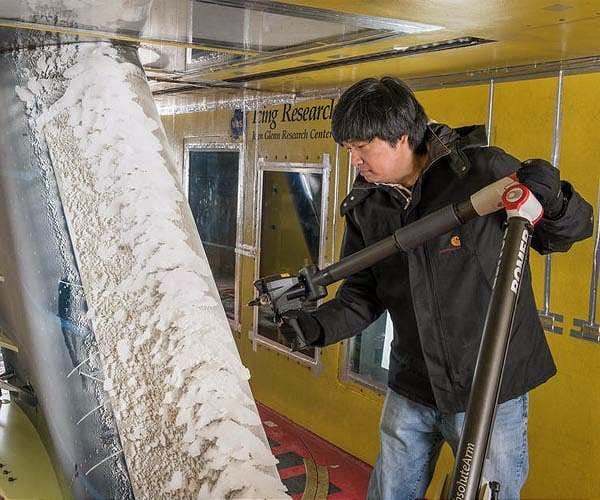![NASA contractor 3D scanning wing ice [Source: Space Daily]](https://fabbaloo.com/wp-content/uploads/2020/05/image-asset_img_5eb0912d4ab13.jpg) NASA contractor 3D scanning wing ice [Source: Space Daily]
NASA contractor 3D scanning wing ice [Source: Space Daily]
NASA has been doing significant research on wing icing using 3D printing and 3D scanning technologies.
Wing icing is something any flyer is familiar with: as an aircraft ascends and descends it can travel through regions of vastly different temperatures and humidities. These can create situations where ice forms on the wings of the aircraft, potentially compromising their ability to provide lift.
Deadly Wing Icing
Imagine an aircraft that’s been flying in a -75C region descending into a tropical humid flight path. The humid air would condense and/or freeze on the wings. These ice structures disrupt the natural smooth airflow over the wings, which normally provide lift force. By disrupting that force, the aircraft could potentially crash.
[UPDATE] We received some further information on exactly how icing situations occur from Jacques Lengaigne, Étudiant au doctorat at Polytechnique Montréal, who is working in this very field. He explains:
“In the introduction (Deadly wing icing), an hypothetic icing incident is describe and refers to the condensation of humidity on a cold aircraft. However this is not a realistic case of ice accretion on aircraft. In fact most aircraft icing incidents occurs, yes in flight but from clouds of tiny micrometric supercooled water droplets.
In quantitative terms these water droplets: have diameters of 10 to 50 micrometers (generally accepted but there is exceptions), are supercooled (that is temperatures below freezing point of water) and liquid (yes they are still liquid despite the temperature). In this highly unstable state, droplets impinging on exposed surfaces (wings, engine inlets, sensors, windshield, etc) will almost instantaneously freeze and quickly form an ice layer with all the bad consequences you can imagine.”
To avoid this aircraft are occasionally doused with de-icing agent before take-off. In my personal experience, this often occupies a significant time delay as there is frequently a lineup for the de-icing station.
Simulated Wing Icing
NASA hopes to change all this by doing research on the wing ice process.
This is apparently done by placing a super-cold wing within a wind tunnel, where tiny water droplets can strike the wing and freeze. Eventually larger ice structures are built through the accumulation of ice particles.
Apparently in the past NASA researchers would simply physically saw off a cross-section of the wing and manually trace the ice structure geometry. This limited data was used to provide aircraft developers information on how ice forms on wings. From that information the aircraft designers would create wing structures that would hopefully minimize the negative aerodynamic effects of said ice.
But if the information was so limited, how effective could the wing designs be?
Optimize Wing Shapes for Icing
Instead, NASA’s research project would 3D scan the ice structures from the wind tunnel in great detail. This 3D model could then be used to properly optimize wing shapes to account for icing.
NASA and aircraft designers could literally 3D print a wing with “ice” on it by using the 3D models.
It seems NASA did run into a problem when doing such 3D prints, as their normal 3D print service performed normal post-processing on the “ice” print by smoothing it out, thinking the wobbly surface was a printing artifact. Eventually, NASA got that straightened out and research proceeded.
The NASA research project is set to complete next year when the final data is released to the public — and especially aircraft designers, who will no doubt design far more reliable aircraft wings in the future.
Via Space Daily

